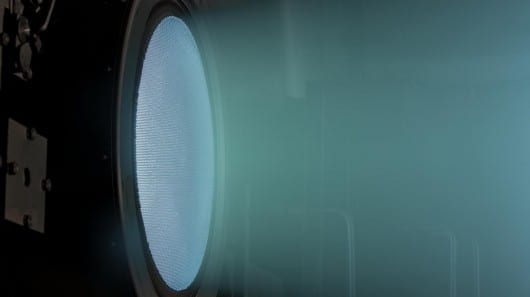The seven-kilowatt thruster is intended to propel future NASA deep space probes on missions where chemical rockets aren’t a practical option.
NASA’s Evolutionary Xenon Thruster (NEXT) ion engine has set a new world record by clocking up 43,000 hours of continuous operation at NASA’s Glenn Research Center’s Electric Propulsion Laboratory. The seven-kilowatt thruster is intended to propel future NASA deep space probes on missions where chemical rockets aren’t a practical option.
Ion propulsion has come a long way from the 1960s when it was an engineering curiosity with a cool Star Trek name. Instead of burning fuel, an ion thruster gets its electrical power from solar panels or a nuclear power source. It uses this electricity to ionize molecules (in NEXT’s case, xenon) and then a cathode to accelerate them electrostatically. As the molecules shoot out the back of the engine, they create thrust.
That sounds simple, but the amount of thrust is tiny – about the equivalent of the weight of a coin resting on a table. Where the ion thruster has it over chemical rockets is, firstly, in terms of efficiency – ion thrusters are 10 to 12 times as fuel efficient as chemical rockets. Secondly, an ion thruster can run for a much longer period of time. Where chemical rockets burn for minutes, ion thrusters can burn for thousands of hours, which allows that tiny amount of thrust to build up into speeds needed for deep space missions.
The NEXT ion thruster is one of NASA’s latest generation of engines.
via Gizmag – David Szondy
The Latest Streaming News: Ion thruster updated minute-by-minute
Bookmark this page and come back often
Latest NEWS
Latest VIDEO








